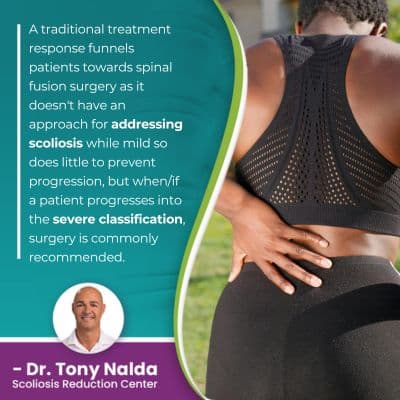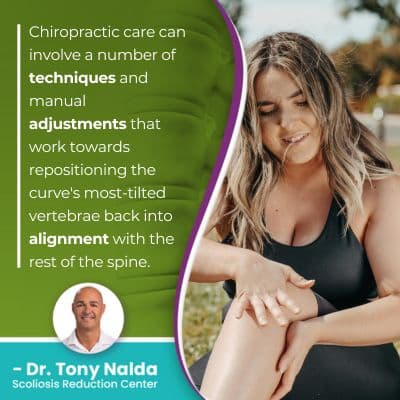Is Scoliosis Back Surgery Right for You? Alternatives Explained

Each patient's condition is unique, and patients have to make informed treatment choices. What's important is awareness of the different treatment options available, rather than being funneled in the direction of surgery as the only presented treatment option.
Not all cases of scoliosis require surgical treatment; there are nonsurgical treatment alternatives with proven results. A conservative chiropractic-centered approach is a less invasive treatment option that doesn't carry the potential risks of spinal fusion surgery.
Being diagnosed with scoliosis means an unnatural sideways bending and twisting spinal curve has developed, so let's start with how it's diagnosed.
Table of Contents
Diagnosing Scoliosis
Being diagnosed with scoliosis can be overwhelming, especially for young people.
Scoliosis introduces a lot of uneven forces to the body that change its appearance and movement, and particularly for adults, scoliosis can also involve different types of pain caused by compression.
There are a number of spinal conditions that cause a loss of its healthy curves, but scoliosis is unique in a number of ways; it's progressive, 3-dimensional, and can affect all ages.
Being diagnosed with scoliosis means being diagnosed with a progressive condition that has it in its nature to get worse over time, and as scoliosis causes the spine to bend unnaturally to the side and also twist, it's a complex 3-dimensional condition.
While scoliosis is most often diagnosed in adolescents between the ages of 10 and 18 as adolescent idiopathic scoliosis, babies can be born with congenital scoliosis, infantile scoliosis is diagnosed between 6 months and 3 years old, juvenile scoliosis between 3 and 10 years old, adolescent idiopathic scoliosis, and adult scoliosis is diagnosed once skeletal maturity has been reached.
Degenerative scoliosis is caused by natural age-related spinal degeneration and affects older adults.
Diagnosing scoliosis involves a physical examination that includes taking the patient's family history, medical history, and examining the spine while in a forward bend position.
If a screening exam finds condition indicators, a scoliosis X-ray is necessary to truly see what's happening in and around the spine, to determine the patient's Cobb angle, and confirm a rotational component.
So if scoliosis is diagnosed, patients have an important decision to make: how to address the condition with treatment.
Scoliosis Treatment Options
 There are two main scoliosis treatment approaches, surgical treatment or nonsurgical treatment.
There are two main scoliosis treatment approaches, surgical treatment or nonsurgical treatment.
A traditional treatment response funnels patients towards spinal fusion surgery as it doesn't have an approach for addressing scoliosis while mild so does little to prevent progression, but when/if a patient progresses into the severe classification, surgery is commonly recommended.
A conservative nonsurgical treatment response is proactive so has the goal of working towards preventing progression and does so by starting treatment as close to the time of diagnosis as possible, when conditions are going to be at their mildest and most responsive.
Scoliosis Surgery
When it comes to scoliosis surgery, this is a type of spinal fusion, and while there are different types, some considered minimally invasive spine surgery for scoliosis, the basic concept is the same.
The curve's most-tilted vertebrae at the apex will be fused together as one solid bone, and this often involves the removal of intervertebral discs that sit between adjacent vertebral bodies to be fused, a bone graft can be involved, and metal rods are commonly attached to the spine with pedicle screws to hold it in place.
Holding the spine in a corrective position through artificial means is not the same as working towards actual corrective results by addressing the actual structural issues within the spine.
While scoliosis surgery can successfully stop progression and straighten a scoliotic spine, the procedure itself comes with some potential risks and complications:
- Excessive blood loss
- Nerve damage
- Adverse reaction to hardware used
- Infection
The long-term effects of scoliosis surgery, however, are more concerning because a fused spine is weaker and more vulnerable to injury, and is also less flexible, and for some, more painful.
An orthopedic surgeon will have their patients' best interests at heart, but spinal surgery can be particularly risky as the spine not only gives the body structure and protects important organs, but also works in tandem with the brain to form the body's central nervous system.
So even minimally invasive scoliosis surgery can be risky, and while not all patients will experience side effects and complications, the risk is there so should be considered carefully, and there is an effective nonsurgical treatment alternative.
Conservative Nonsurgical Scoliosis Treatment Alternative
Patients of the Scoliosis Reduction Center® benefit from nonsurgical scoliosis treatment that works towards preserving as much of the spine's natural strength and function as possible; it's a safer, more natural, less invasive alternative to surgical options.
Conservative treatment wants to help scoliosis patients avoid the risks of spinal fusion and does so by working towards preventing progression, increasing condition effects, and the need for surgical treatment in the future.
Conservative treatment is integrative and combines chiropractic care, physical therapy, corrective bracing, and rehabilitation so conditions can be impacted on every level.
A scoliosis specialist is recommended for treatment as the complexity of the condition is beyond the scope of general medical care and requires a specialized approach.
Chiropractic care can involve a number of techniques and manual adjustments that work towards repositioning the curve's most-tilted vertebrae back into alignment with the rest of the spine.
Physical therapy designed by a scoliosis-specific physical therapist can help prepare the spine and its surroundings for treatment, making it more responsive, and strengthening the core muscles means more support and stability for the spine.
A muscular imbalance, which scoliosis is associated with, can also be addressed with physical therapy.
Corrective bracing is particularly effective on growing spines so is commonly used for treating adolescent idiopathic scoliosis; bracing can help by pushing the spine into a corrective position, complementing other treatments applied.
Flexible braces like the ScoliBrace can help growing children counteract the condition's progressive nature.
Rehabilitation can involve continued chiropractic care and the prescription of scoliosis-specific exercises that patients can perform from home to further heal and stabilize their spines.
While there are never treatment guarantees and each case is unique, many scoliosis patients don't need surgery.
The Benefit of Nonsurgical Scoliosis Treatment vs Scoliosis Surgery
 There are many benefits to a less-invasive treatment approach; all surgeries come with their share of risks, and spinal fusion is no exception.
There are many benefits to a less-invasive treatment approach; all surgeries come with their share of risks, and spinal fusion is no exception.
Once spinal fusion is performed, the spine is fused for life. The hardware attached is permanent, and while not a common complication, a metal rod or screw can fail, break, crack, come loose, and the only recourse is additional surgery.
The risks of spinal fusion surgery and repair increase with each procedure and increasing age, and remember, the younger a patient is at the time of diagnosis, the longer the hardware has to last.
While some patients maintain enough flexibility above and below the fusion site to not experience a noticeable range of motion loss, many find the loss in spinal flexibility to disrupt quality of life, and as a fused spine is weaker and more vulnerable to injury, this can have a psychological effect; patients can be fearful of trying new activities and/or participating in once-loved sports.
A spine that's treated conservatively is one that is strong and flexible because treatment focuses on preserving as much of the spine's natural strength and function as possible.
Daily living and quality of life is better for patients who don't experience increased back pain due to the fusion and immovable portion of the spine, and if conservative treatment is unsuccessful, other types of treatment can be applied.
Conclusion
Scoliosis back surgery is a type of spinal fusion, and while there are different types, some considered minimally invasive (open surgery, some that use an anterior approach, a posterior approach, small incisions), the concept is the same and involves fusing the spine so it can't become more unnaturally tilted over time.
Having any portion of the spine immovable, which is contrary to its movement-based design, can come at a cost, and for many patients, that cost is the spine's flexibility and range of motion, and for others, it can be increasing levels of back pain.
When spinal alignment is improved through conservative treatment, the underlying structural nature of scoliosis is addressed, as is its rotational component, and its progressive nature.
As a progressive condition, scoliosis treatment is more about managing an ongoing condition than reaching a cure, and achieving a balanced spine can mean unrestricted activities and preventing scoliosis from getting worse.
Children with scoliosis need to be taken seriously because as progression is triggered by growth, as a child grows, they are at risk for rapid progression, and a few months of growing can make the condition more difficult to treat.
Early postural changes that affect children can include a rib hump, uneven shoulders and uneven shoulder blades, and awareness of the condition's early signs can help lead to early detection, intervention, and treatment success.
Dr. Tony Nalda
DOCTOR OF CHIROPRACTIC
After receiving an undergraduate degree in psychology and his Doctorate of Chiropractic from Life University, Dr. Nalda settled in Celebration, Florida and proceeded to build one of Central Florida’s most successful chiropractic clinics.
His experience with patients suffering from scoliosis, and the confusion and frustration they faced, led him to seek a specialty in scoliosis care. In 2006 he completed his Intensive Care Certification from CLEAR Institute, a leading scoliosis educational and certification center.
About Dr. Tony Nalda
 Ready to explore scoliosis treatment? Contact Us Now
Ready to explore scoliosis treatment? Contact Us Now





